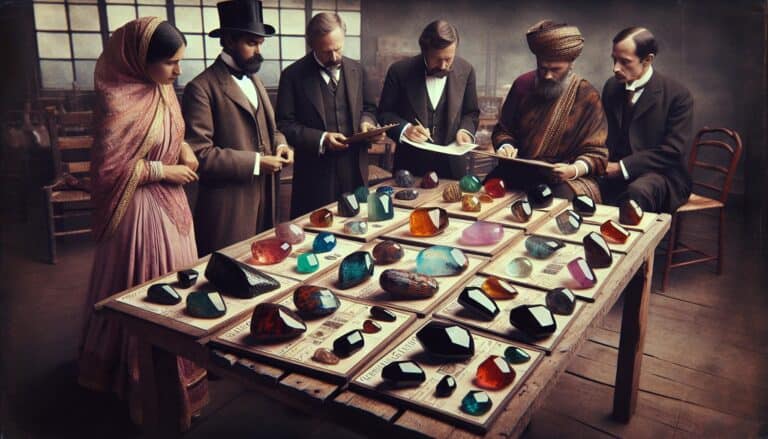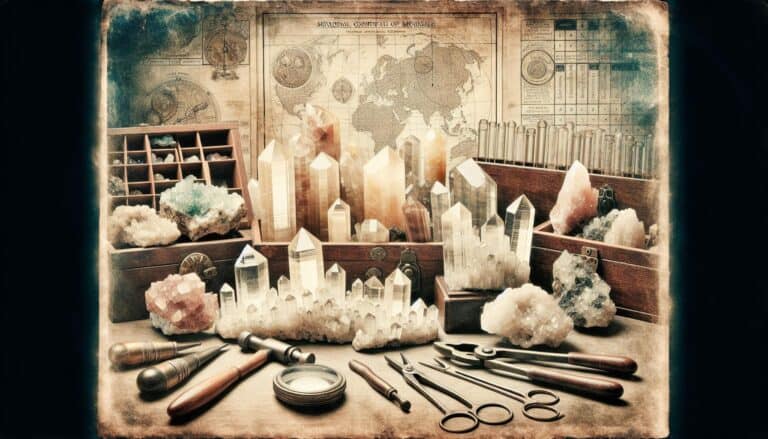Discover the fascinating world of alexandrite, a gemstone renowned for its striking color-change phenomenon.
As you delve into the art of gem identification, you’ll learn how to spot genuine alexandrite, distinguishing it from its many look-alikes.
Understanding alexandrite’s unique properties is key to identifying this rare gem. You’ll find out about its origins, what sets it apart, and the simple tests you can perform to confirm its authenticity.
Get ready to become a savvy alexandrite spotter with these expert tips.
To identify alexandrite, observe its color change from green in daylight to red in incandescent light. It’s typically transparent with minor inclusions. Perform a streak test (white streak), magnet test (slight response), and hardness test (scratch with steel file). Alexandrite shows single refraction and has a specific gravity around 3.73.
How to Identify Alexandrite Through Testing
Identifying authentic alexandrite requires careful analysis. By understanding how to perform several tests, you can help ensure that you’re examining a genuine specimen.
Visual Inspection
Begin with a visual inspection under different lighting conditions. Alexandrite should exhibit a notable color change—from green in daylight to red in incandescent light. Look for clarity and inclusions that can indicate its natural origin. Natural alexandrite often contains minor imperfections, unlike synthetic counterparts.
The Streak Test
Perform a streak test using a piece of unglazed porcelain tile. When you drag the gemstone across the tile, genuine alexandrite will leave a white streak. Note that this test should be done with care to avoid damaging the gemstone.
Magnet Test
Although not definitive, the magnet test can be indicative. Since alexandrite contains iron, it may show a slight magnetic response. Bring a strong magnet close to the stone and observe any attraction. Keep in mind, not all natural stones will react.
Hardness Test
Use the Mohs scale to determine hardness. Alexandrite ranks at 8.5, meaning it should be able to scratch quartz (ranked at 7) but not diamond (ranked at 10). Be cautious to prevent marring the gem.
Birefringence Test
A birefringence test identifies the splitting of light rays as they pass through the gemstone. Alexandrite should not show birefringence when viewed under a polariscope. This is due to its crystalline structure which is singly refractive.
Checking The Diaphaneity
Assess the gemstone’s diaphaneity, or the degree to which light passes through it. Alexandrite ranges from transparent to opaque. If you have a loop or magnifying glass, examine how light interacts with the stone.
Single or Double Refraction
Determine if the gemstone is singly or doubly refractive. Alexandrite is a single-refraction gemstone, so it should not display double refraction when examined under a jeweler’s loupe or microscope.
Refractive Index Test
Measure the refractive index using a refractometer. The refractive index of alexandrite fluctuates between 1.746 – 1.755. Values outside this range may suggest a different material.
Finding The Specific Gravity
Calculate the specific gravity (SG) by comparing the weight of the alexandrite in air versus water. Alexandrite’s SG should be around 3.73. Discrepancies could indicate a different stone.
Identifying Alexandrites in the Field
When you’re in the field, seek signs of chromium as it’s the trace element causing alexandrite’s color change. Look out for locations where chrysoberyl crystals are typically found—often alongside quartz and mica.
Recognizing Potential Alexandrite Rocks
Look for host rocks. Alexandrite is commonly found within mica schists and contact metamorphosed calcareous rocks. If you spot these rock types, you could potentially uncover alexandrite.
Physical Characteristics of Alexandrite

When attempting to identify genuine alexandrites, familiarizing yourself with their physical characteristics is crucial. Renowned for their remarkable color-changing ability, alexandrites appear green to bluish-green in daylight or fluorescent light, and red to purplish-red under incandescent light. This unique phenomenon is known as pleochroism, and it’s a telltale sign of the stone’s authenticity.
Color change isn’t the only notable feature. Alexandrites are rated 8.5 on the Mohs scale of hardness, meaning they are quite resistant to scratches and abrasions. Considering their durability, jewelry with alexandrite makes for an excellent daily wear choice.
The crystal structure of alexandrite must not be overlooked. They belong to the orthorhombic crystal system and display a vitreous luster when cut and polished. The stones are also transparent to translucent, a quality you can assess by observing light pass through the gem.
Beyond the mesmerizing visual traits, alexandrites boast certain optical properties that are not immediately visible to the naked eye. When subjected to light, some alexandrites may exhibit chatoyancy or a cat’s eye effect, which further confirms their identity. If you’re examining a rough sample, look for a blurred, milky appearance within the crystal structure; this can also indicate genuine alexandrite.
How Are Alexandrite Formed?
Alexandrite gemstones emerge from a unique set of geological conditions. Chromium, a key element in alexandrite’s color change, becomes incorporated into the crystal structure during formation. This happens in zones where the Earth’s crust has been altered, particularly in pegmatites and metamorphic rocks.
Pegmatites, which are igneous rocks, provide an environment rich in fluids that allows for the growth of large crystal grains. Alexandrite crystals grow when beryllium-rich pegmatites interact with chromium-rich rocks in the Earth’s crust. The presence of beryllium is crucial because alexandrite is actually a type of chrysoberyl, which requires this element to form.
Aside from pegmatites, alexandrite can also be found in metamorphic rock deposits transformed by high temperatures, pressure, and fluid interaction. These changes in pre-existing rocks often result in the formation of alexandrite through a process called metasomatism, where the chemical components of the rock are drastically altered, allowing for chromium to be integrated.
- Presence of Chromium: Essential for the gemstone’s distinctive color change.
- Pegmatites and Metamorphic Rocks: The primary hosts for alexandrite crystal growth.
- Metasomatism: A key process integrating chromium into the forming crystal.
It’s in these specific geological niches that the magic of alexandrite is born. The balance of beryllium, silica, oxygen, and particularly chromium, leads to the birth of this remarkable gemstone.
Understanding the formation of alexandrite directs you to geographical regions you might explore. Some notable sources include the Ural Mountains in Russia — known for producing fine quality gems — as well as Brazil, Sri Lanka, and Madagascar. Each source provides alexandrite with subtle differences in hue and quality, influenced by the unique geological recipes of the regions.
Preparation for Alexandrite Hunting
Gathering the Right Tools
Before you embark on your alexandrite hunting adventure, it’s critical to arm yourself with the necessary tools. Proper equipment can make the difference between a fruitful search and a frustrating experience. To start, you’ll need a good quality jeweler’s loupe with at least 10x magnification to closely inspect potential finds. A portable hardness testing kit will help you confirm the gemstone’s hardness, a characteristic feature of real alexandrite.
Bring along a UV light; it can help you spot the unique fluorescence that some alexandrites emit. Don’t forget a pair of tweezers or a gem holder for handling small stones, and small containers or bags for storing any specimens you may find.
Safety Considerations
Prioritizing your safety while hunting for alexandrites is paramount. Always let someone know where you’re going and when you expect to return, especially if you’re heading into remote areas. Wear sturdy footwear and protective clothing appropriate for the terrain and weather conditions. Remember, you might encounter wildlife or rough terrain, so it’s smart to bring along a first-aid kit and learn the basics of wilderness safety.
Since hunting for alexandrites can be a day-long endeavor, pack plenty of water and high-energy snacks. Additionally, consider carrying a whistle, a map, a compass, and a GPS device for navigation. Lastly, make sure your mobile phone is fully charged, and if possible, carry an extra power bank—you never know when you’ll need it.
Handling and Care of Found Alexandrite

Cleaning Alexandrites
Once you’ve successfully identified and collected alexandrite, it’s crucial to clean your gemstones properly. Begin with a soft brush and warm, soapy water to gently remove any dirt or debris. It’s important to avoid harsh chemicals, steam cleaners, or ultrasonic cleaners, as these can damage the gemstone or alter its natural state. After cleaning, rinse your alexandrite thoroughly with clean water and dry it with a soft, lint-free cloth.
Storing Alexandrites
Proper storage is key to preserving the beauty and integrity of your alexandrites. Store each piece separately to prevent scratches or damage from other gemstones or jewelry. Consider using soft, padded jewelry boxes or individual pouches made of a gentle fabric. If you opt for containers, ensure they are airtight to protect the stones from humidity and environmental changes. Keep your alexandrites in a cool, dry place away from direct sunlight, which can cause the colors to fade over time.
Remember, regular inspections of your alexandrite collection for any signs of wear or damage can help maintain their condition. Being mindful of environmental factors and handling your gemstones with care will keep your alexandrites shining for years to come.
Conclusion: Confirming Real Alexandrite
Armed with the right knowledge and tools, you’re now ready to venture into the world of alexandrite hunting with confidence.
Remember to trust your instincts and use the techniques you’ve learned to test for authenticity. Whether you’re examining a stone’s unique color-change in natural light or assessing its hardness, each test brings you closer to a definitive identification. Care for your finds with the gentle methods suggested, and they’ll maintain their mystique for years to come.
Keep your treasures safe and your adventures safer, and you’ll not only enjoy the hunt but also the satisfaction of uncovering the true beauty of alexandrite.







